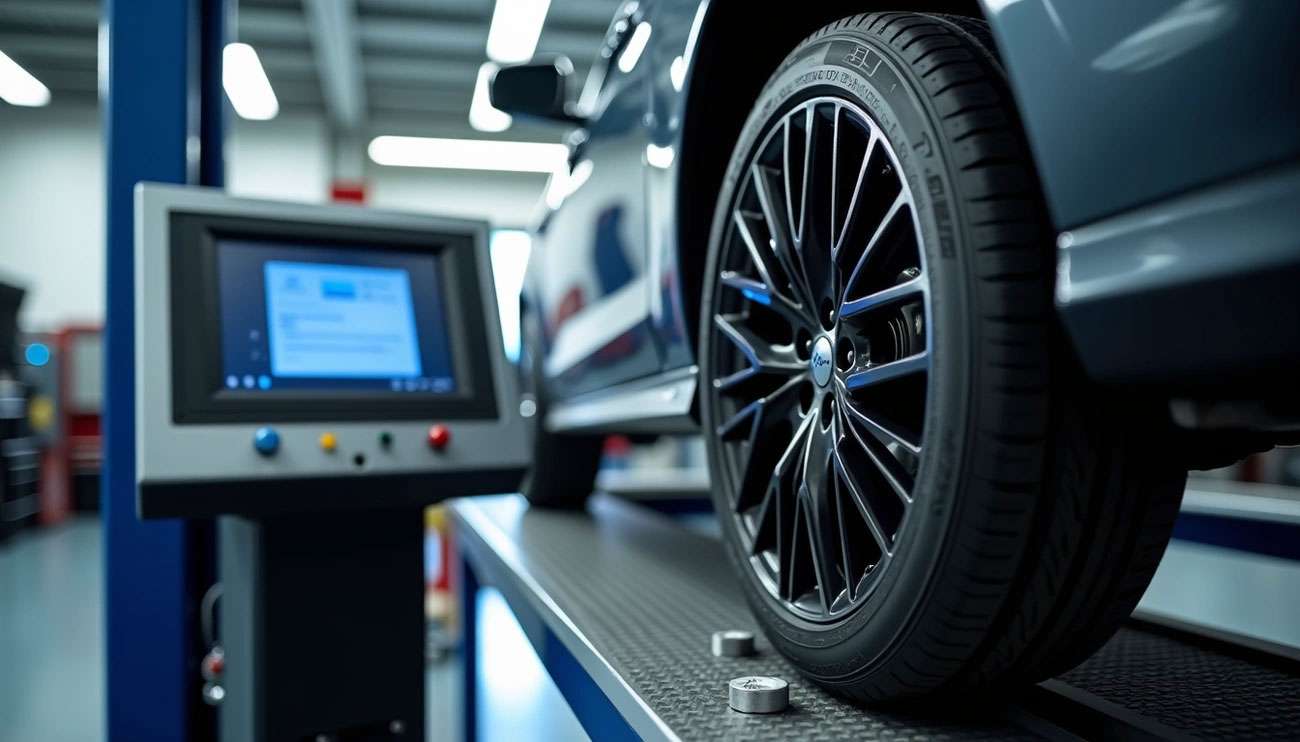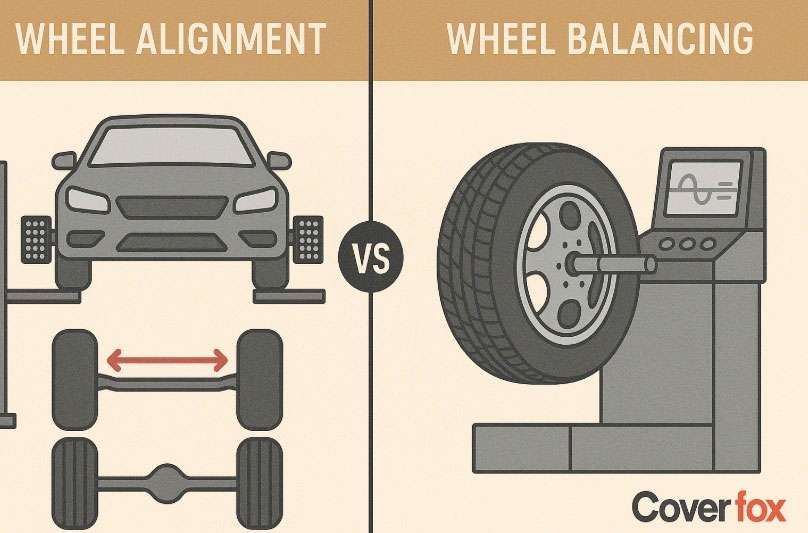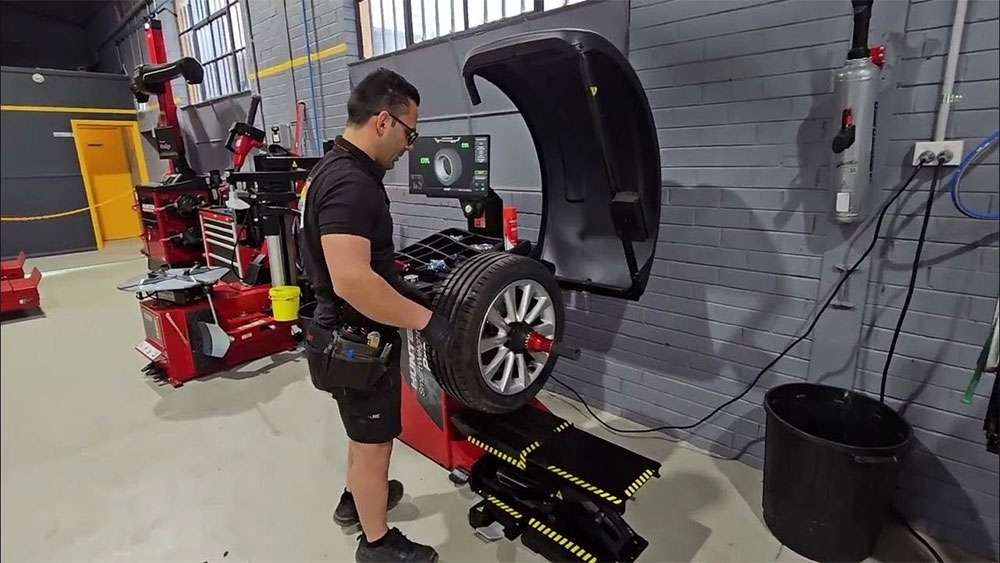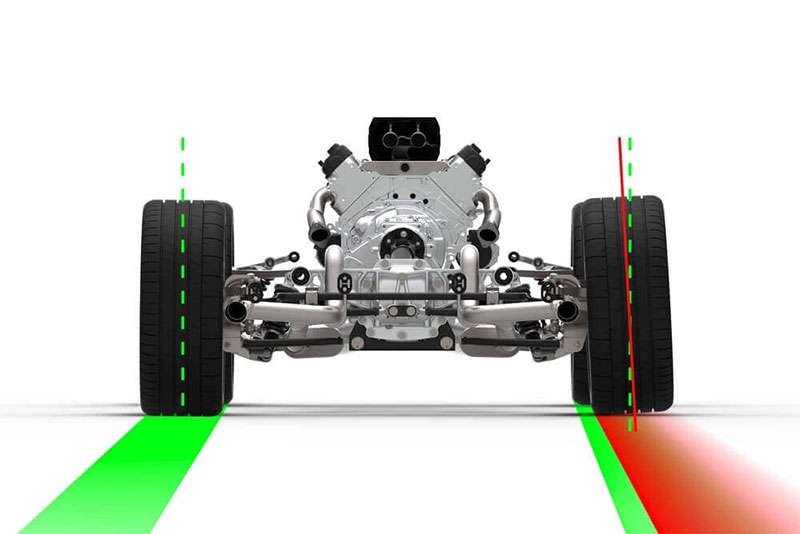
Unbalanced tires create vibrations in your steering wheel that get worse as speeds increase. Tire balancing corrects this problem by adding small weights to your wheels, ensuring all parts of your tire and wheel assembly distribute weight evenly around the center.
Unbalanced tires cause more than just annoying vibrations in your steering wheel or floorboard. They create uneven tread wear patterns, reduce fuel economy, and can affect your vehicle's overall range. That's why tire professionals recommend balancing your tires every 5,000 to 6,000 miles to maximize their lifespan and maintain peak performance.
Tire balancing works on a simple principle: distribute weight equally around the entire tire circumference. Continental suggests rebalancing after every 5,000-10,000km of driving or every 1-2 years, whichever comes first. This straightforward maintenance prevents early tire replacement and saves money by extending tire life.
We'll show you everything you need to know about tire balancing, from spotting the warning signs to understanding professional balancing methods. You'll also learn how tire balancing differs from wheel alignment and why both services are crucial for your vehicle's performance and safety.

Image Source: Coverfox.com
Most drivers mix up tire balancing and wheel alignment, but these are two completely different maintenance services that solve different problems. Understanding these differences helps you make better decisions about your vehicle's care.
Tire balancing equalizes weight distribution around your tire and wheel assembly. Manufacturing creates slight weight variations in both tires and wheels. Just 0.25 ounces of weight imbalance creates noticeable vibrations at highway speeds. Technicians correct this by placing small weights at specific points around the wheel to create smooth rotation.
Tire balancing focuses on weight distribution issues, while alignment deals with wheel angles. The service typically costs between $15-$75 per tire, depending on your location and vehicle type.
Balanced tires eliminate vibrations that travel through your steering wheel, seat, or floorboard. This maintenance task distributes wear evenly across all tires, extending their lifespan significantly.
Balanced tires also reduce stress on your vehicle's suspension components and bearings. They maintain proper contact with the road surface, improving handling during emergency maneuvers and adverse weather conditions.
These procedures address completely different problems:
Tire balancing corrects weight distribution around the wheel and tire assembly, fixing vibration and uneven wear issues. A specialized balancing machine identifies exactly where weights should be placed.
Wheel alignment adjusts wheel angles to match manufacturer specifications. Alignment corrects the direction your tires point relative to each other and the road. Proper alignment ensures your vehicle tracks straight, while balancing ensures smooth wheel rotation.
Both services are essential maintenance tasks, but they follow different schedules. Tires should be balanced during rotation (every 5,000-7,000 miles) while alignment is needed less frequently.

Image Source: Motor 283
Spotting unbalanced tires early can save you from expensive repairs and keep you safer on the road. Here are the key warning signs that tell you it's time for tire balancing.
Vibrations typically show up first at speeds between 50-70 mph. Front tire problems create vibrations you'll feel in the steering wheel, while rear tire issues cause vibrations in your seat or floor. These aren't just comfort problems—they actually damage your suspension system over time.
You might also hear a rhythmic "thump-thump-thump" sound that gets louder at certain speeds. This thumping noise usually comes with the vibrations and becomes more obvious as you drive faster.
Unbalanced tires don't wear evenly across their surface. You'll see patches of heavy wear next to areas that look barely used. This irregular wear pattern shortens tire life and forces early replacement.
Check your tread depth at different spots around each tire. Finding a difference of 1/16" or more in tread depth means your tires are wearing unevenly.
While often mistaken for alignment issues, unbalanced tires can make your vehicle drift slightly to one side. The weight imbalance creates unequal forces that essentially pull your car in a specific direction.
This drifting becomes most noticeable on straight roads where you need constant steering corrections to maintain your lane.
Unbalanced tires increase rolling resistance, making your engine work harder to maintain speed. This extra effort directly reduces your miles per gallon.
Even small tire imbalances can decrease fuel efficiency significantly, as uneven weight distribution creates additional resistance against the road surface. Over months of driving, this inefficiency adds up to substantial extra fuel costs.

Image Source: YouTube
Tire shops use sophisticated balancing machines to eliminate vibrations and ensure smooth wheel rotation. Understanding this technical process helps you appreciate why professional balancing delivers superior results.
Tire balancing uses two distinct approaches depending on your vehicle's needs. Static balancing corrects vertical weight imbalances in a single plane, making it ideal for narrow tires like motorcycle wheels. This method eliminates the "hop" motion by placing counterweights opposite the heavy spot.
Dynamic balancing provides comprehensive correction by addressing weight distribution in two planes—vertical and lateral. Modern vehicles with wider tires require this advanced method to prevent the "shimmy" effect that accelerates tire wear. Dynamic balancing ensures your wheels rotate smoothly at all speeds.
The balancing process starts with thorough wheel cleaning and mounting on a specialized machine. Technicians select the correct collet size and secure the wheel with the appropriate hub nut. High-speed spinning allows precision sensors to detect even minor weight variations.
Computer analysis calculates the exact placement for counterweights, typically measured in quarter-ounce increments. These small lead or zinc weights attach strategically to both inner and outer rim edges to achieve perfect balance. A final verification spin confirms zero additional weight is needed.
Most tire manufacturers specify rebalancing every 5,000-10,000 kilometers or 3,000-6,000 miles. Immediate rebalancing becomes necessary after:
Installing new tires or wheels
Impact damage from potholes or curbs
Detecting steering wheel vibrations
Flat tire repairs or patches
Discovering irregular tread wear patterns
Professional tire shops often combine balancing with rotation services since both require wheel removal. This efficient approach saves time and ensures optimal tire performance. Balancing is also standard practice following any tire repair, as patches or plugs can alter the wheel's weight distribution.

Image Source: Perth City Subaru
Balanced tires offer significant value that goes far beyond eliminating vibrations. This essential maintenance delivers multiple benefits that improve both your driving experience and save you money.
Balanced tires eliminate vibrations that travel through your steering wheel or floorboard. The difference is immediately noticeable, especially during highway driving and long trips. More importantly, properly balanced tires improve vehicle stability and handling, making your car respond better to steering inputs. This enhanced stability gives you better control during emergency situations and poor weather conditions, which can help prevent accidents.
Proper tire balancing delivers real fuel savings. Studies show balanced tires can boost fuel efficiency by up to 2.2%. This happens because balanced tires roll smoother with less road resistance. Your engine works less to maintain speed, putting money back in your pocket over time.
Balanced tires wear evenly across the tread surface, preventing the premature replacement that uneven wear causes. This even wear pattern maximizes your tire investment. The benefits extend to your suspension system too. Balancing reduces stress on shocks, struts, wheel bearings, and tie rods. This protection keeps your suspension components working properly longer.
Regular tire balancing pays for itself many times over. You avoid buying tires before their time. You also protect expensive suspension parts from vibration damage that leads to costly repairs. Even steering components last longer when your tires stay properly balanced. When you add up the savings from extended tire life, fewer repairs, and better fuel economy, tire balancing becomes one of the smartest maintenance investments you can make.
Balanced tires are essential for vehicle performance, safety, and your wallet. This guide has shown you how proper tire balancing affects ride comfort, fuel economy, and long-term maintenance costs. Spotting the warning signs early—steering wheel vibrations, uneven tread wear, vehicle pulling, and poor fuel efficiency—prevents bigger problems down the road.
Tire balancing every 5,000-6,000 miles delivers exceptional value for such a simple service. This maintenance eliminates uncomfortable vibrations and protects your suspension components from costly damage. The service typically costs $15-75 per tire but prevents hundreds in premature tire replacements and suspension repairs.
Don't confuse tire balancing with wheel alignment. Balancing corrects weight distribution problems while alignment adjusts wheel angles. Your vehicle needs both services, but they solve different issues and require different maintenance schedules.
Properly balanced tires transform your driving experience. You'll notice smoother highway cruising, better handling response, and improved fuel economy. Most importantly, balanced tires provide superior control during emergency situations and bad weather conditions.
Your tires are the only contact point between your vehicle and the road. Regular tire balancing keeps them performing at their best while maximizing their lifespan. Schedule tire balancing as part of your routine maintenance, and you'll enjoy better performance, extended tire life, and significant cost savings.
At Performance Plus Tire, we provide professional tire balancing services that keep your vehicle running smoothly. Our experienced technicians use state-of-the-art equipment to ensure perfect balance every time.
Understanding tire balancing fundamentals and recognizing warning signs can save you money while ensuring safer driving experiences.
• Get tires balanced every 5,000-6,000 miles to prevent vibrations, uneven wear, and costly suspension damage • Watch for steering wheel vibrations at 50-70 mph - this is the primary sign your tires need immediate balancing • Tire balancing differs from alignment - balancing fixes weight distribution while alignment adjusts wheel angles • Balanced tires improve fuel efficiency by up to 2.2% and extend tire life by preventing premature replacement • Professional balancing costs $15-75 per tire but saves hundreds in avoided repairs and tire replacements
Regular tire balancing is one of the most cost-effective maintenance services available, delivering immediate comfort improvements and long-term financial benefits through extended tire life and reduced mechanical wear.
It's recommended to have your tires balanced every 5,000 to 6,000 miles or when you notice vibrations while driving. This regular maintenance helps prevent uneven wear and extends the life of your tires.
Common signs include vibrations in the steering wheel or seat (especially at speeds between 50-70 mph), uneven or rapid tread wear, your vehicle pulling to one side, and increased fuel consumption.
No, they are different procedures. Tire balancing ensures even weight distribution around the tire and wheel assembly, while wheel alignment adjusts the angles of your wheels to match manufacturer specifications.
The cost of tire balancing usually ranges from $15 to $75 per tire, depending on your location and vehicle type. Despite the cost, it's a cost-effective maintenance service that can save you money in the long run.
Balanced tires provide a smoother and safer ride, improve fuel efficiency by up to 2.2%, extend the life of your tires and suspension components, and reduce long-term maintenance costs by preventing premature wear and tear.